#Writing tips
Text
NEED HELP WRITING? (a masterlist)
I have likely not added many that I've reblogged to this list. Please feel free to roam my blog and/or ask/message me to add something you'd like to see on this list!
Synonym Lists
Look by @writers-potion
Descriptors
Voices by @saraswritingtipps
Show, Don't Tell by @lyralit
Tips & Tricks
5 Tips for Creating Intimidating Antagonists by @writingwithfolklore
How To (Realistically) Make a Habit of Writing by @byoldervine
Let's Talk About Misdirection by @deception-united
Tips to Improve Character Voice by @tanaor
Stephen King's Top 20 Rules for Writers posted by @toocoolformedschool
Fun Things to Add to a Fight Scene (Hand to Hand Edition) by @illarian-rambling
Questions I Ask My Beta Readers by @burntoutdaydreamer
Skip Google for Research by @s-n-arly
Breaking Writing Rules Right: Don't Write Direct Dialogue by @septemberercfawkes
Databases/Resources
International Clothing
Advice/Uplifting
Too Ashamed of Writing To Write by @writingquestionsanswered
"Said" is Beautiful by @blue-eyed-author
652 notes
·
View notes
Text
“One word after another. That’s the only way that novels get written.”
— Neil Gaiman
#neil gaiman#on writing#insp#author quotes#authors#writers#creative writing#writing#writing community#writers of tumblr#creative writers#writing inspiration#writeblr#writerblr#writing tips#author#writblr#writer stuff#writer things#writers cor#writers corner#wr#writers block#writers and poets#writing advice#writers on tumblr#block#beat writers block#inspi#creative inspiration
140 notes
·
View notes
Text
You Don't Need an Agent! Publishers That Accept Unsolicited Submissions
I see a few people sayin that you definitely need an agent to get published traditionally. Guess what? That's not remotely true. While an agent can be a very useful tool in finding and negotiating with publishers, going without is not as large of a hurdle as people might make it out to be!
Below is a list of some of the traditional publishers that offer reading periods for agent-less manuscripts. There might be more! Try looking for yourself - I promise it's not that scary!
Albert Whitman & Company: for picture books, middle-grade, and young adult fiction
Hydra (Part of Random House): for mainly LitRPG
Kensington Publishing: for a range of fiction and nonfiction
NCM Publishing: for all genres of fiction (YA included) and nonfiction
Pants of Fire Press: for middle-grade, YA, and adult fiction
Tin House Books: very limited submission period, but a good avenue for fiction, literary fiction, and poetry written by underrepresented communities
Quirk Fiction: offers odd-genre rep for represented and unagented authors. Unsolicited submissions inbox is closed at the moment but this is the page that'll update when it's open, and they produced some pretty big books so I'd keep an eye on this
Persea Books: for lit fiction, creative nonfiction, YA novels, and books focusing on contemporary issues
Baen: considered one of the best known publishers of sci-fi and fantasy. They don't need a history of publication.
Chicago Review Press: only accepting nonfiction at the moment, but maybe someone here writes nonfiction
Acre: for poetry, fiction and nonfiction. Special interest in underrepresented authors. Submission period just passed but for next year!
Coffeehouse Press: for lit fiction, nonfiction, poetry and translation. Reading period closed at time of posting, but keep an eye out
Ig: for queries on literary fiction and political/cultural nonfiction
Schaffner Press: for lit fiction, historical/crime fiction, or short fiction collections (cool)
Feminist Press: for international lit, hybrid memoirs, sci-fi and fantasy fiction especially from BIPOC, queer and trans voices
Evernight Publishing: for erotica. Royalties seem good and their response time is solid
Felony & Mayhem: for literary mystery fiction. Not currently looking for new work, but check back later
This is all what I could find in an hour. And it's not even everything, because I sifted out the expired links, the repeat genres (there are a lot of options for YA and children's authors), and I didn't even include a majority of smaller indie pubs where you can really do that weird shit.
A lot of them want you to query, but that's easy stuff once you figure it out. Lots of guides, and some even say how they want you to do it for them.
Not submitting to a Big 5 Trad Pub House does not make you any less of a writer. If you choose to work with any publishing house it can take a fair bit of weight off your shoulders in terms of design and distribution. You don't have to do it - I'm not - but if that's the way you want to go it's very, very, very possible.
Have a weirder manuscript that you don't think fits? Here's a list of 50 Indie Publishers looking for more experimental works to showcase and sell!
If Random House won't take your work - guess what? Maybe you're too cool for Random House.
#writing community#writeblr#on writing#writers on tumblr#authors of tumblr#queer writers#poc writer#trans writers#ya author#writing tips#writing resources#writing inspiration#writers supporting writers
91 notes
·
View notes
Text
Writing Tips Master Post
Character writing/development:
Character Arcs
Making Character Profiles
Character Development
Comic Relief Arc
Internal Conflict
Creating Distinct Characters
Suicidal Urges/Martyr Complex
Creating Likeable Characters
Writing Strong Female Characters
Writing POC Characters
Character Voices
Plot devices/development:
Intrigue in Storytelling
Enemies to Lovers
Alternatives to Killing Characters
Worldbuilding
Misdirection
Consider Before Killing Characters
Foreshadowing
Narrative:
Emphasising the Stakes
Avoid Info-Dumping
Writing Without Dialogue
1st vs. 2nd vs. 3rd Perspective
Fight Scenes (More)
Transitions
Pacing
Book writing:
Connected vs. Stand-Alone Series
A & B Stories
Miscellaneous:
Overcoming Writer's Block
1000 Follower Special
Writing Fantasy
Character Ask Game
#masterlist#masterpost#writeblr#writing#writing tips#writing advice#writing help#writing resources#author resources#writer resources#creative writing#character writing#character development#plot development#narrative#book writing#writers block#writer stuff#writer things#deception-united
114 notes
·
View notes
Text
#acnl#nope#anabella carrasco#wiccan#zoro#owlboy#johnny suh#writing tips#nogizaka46#dystopian#dean winchester smut#tatoos#kuroo tetsurou
134 notes
·
View notes
Text
Exposition 2: Naming New Characters
This post is brought to you by one of the worst line deliveries in the history of Supernatural: Sam’s reveal of Ruby 2.0 in “Lazarus Rising”. Also a companion post to not playing The Pronoun Game.
—
Introducing new characters to a scene and figuring out the precise moment to announce their name without sounding clunky can be very tricky. So let’s break it down into three scenarios:
Name is known by the narrator to be given in narration
Name is either known by the narrator, to be given in dialogue, or known by another character
Name is not known to anyone in the scene but the new character
Scenario 1: Name via narration
Personally I don’t have any problem whatsoever with: “This is character, they do X.” It’s quick, inoffensive, and doesn’t need to get convoluted and over complicated.
Now, if this is meant to be a reveal to the audience, you’ll have to play the Pronoun Game for a bit until you pull the trigger (so long as it is motivated and reflects back on the characters and isn’t just because the author is bad at suspense), but I’d recommend reworking the scene so your narrator discovers this information with the reader for the lowest risk of confusing your audience.
Generally I think if you introduce a new character into a scene via epithet, then in the next paragraph have the narrator use their name, I think the audience is smart enough to pick up on: “new entity has arrived on stage = unfamiliar name must belong to them” so you can even skip the exposition tag entirely.
The cook returned from the dining room, freshly traumatized by a wild Karen.
Tyler took a breath, steadied themselves, and resumed their station.
Scenario 2: Name via other character, or dialogue
This is the aforementioned Supernatural blunder. There doesn’t appear to be a clip for this specific scene on YouTube so the moment in question:
Ruby: [Walks in through the back door] “Getting pretty slick there, Sam. Better all the time.”
Sam: [Sighs, and contemplates all his life choices that led to this moment] “What the hell’s going on around here, Ruby?” [Pause for dramatic effect and damn-near looks into the camera]
Ruby’s “Sam” is delivered seamlessly and is flavored with some dry wit, in character for Ruby.
Sam, on the other hand, not only pauses before saying her name, but emphasizes her name in a completely unnatural way. I didn't do it justice here explaining how clunky this is, just trust me.
Nothing sounds or reads quite so juvenile like awkwardly tacking on a new character’s name to dialogue when no real person would talk like that. The line serves purely as exposition and it’s glaringly obvious and uncreative?
How to fix? As I said in my other exposition post: Make it motivated. Have the name reveal come with either inflection, tonality, or dual purpose so it’s not just exposition.
Meaning:
Have speaker be trying to get the person’s attention, and call their name
Have the speaker admonish the person, using their name
If this is a happy reunion, have the speaker excitedly exclaim the name
If this is a bad reunion, have the speaker mutter, growl, whisper, or grumble the name
If this is a surprise reunion, have them speak the name like a question
Have the speaker use a nickname the new character doesn’t like, prompting a correction to their real name
Have the speaker blank, prompting the new character to supply it, while offended that they forgot
Have the known character introduce the new character after a few exchanges that isolate the narrator, prompting an explanation a la “Sorry, this is X, they’ve been my friend for years.”
Scenario 3: Name via new character
Very similar to above with the same advice: Make it motivated and double as clueing us in on something either about the new character, or about the characters’ relationship with the scene, or how they see themselves, or how they expect this meeting to go.
If they’re bold, sassy, or snarky, they introduce themselves like they expect their audience to be impressed
Or, if they expect that name to already be known, and are surprised or irritated that they must introduce themselves
Straight up, have someone ask them who they are if they’re not supposed to be there
Or have someone ask them in a social faux pas, blurting out the question and then being embarrassed by doing so
Have the asker be rude, demanding an introduction where it might otherwise not be appropriate
Have them introduce themselves with uncertainty, if they’re shy or unsure about where they’re supposed to be
You get the idea? Whatever it be, make it be in character, and you’ll pull double-duty (as most exposition should) both naming your character and immediately establishing a relationship between your characters.
Scenario 4: When plot demands you must wait
Bonus! This happens when asking for a name would ruin the pacing and be wildly out of place in whatever’s happening (like mid-fight scene), or the narrator is unable to ask for plot reasons.
In which case, this still can pull double-duty by having your narrator come up with their own way of identifying the person: maybe they come up with a cute or insulting nickname, or a unique feature stands out that they’re jealous they don’t have, or there’s an identifiable piece of clothing or uniform to call them by their profession (works well for a group of distinct unknowns), or they’re acting in a suspicious fashion and can be labeled with a derogatory adjective.
At which point, narrator can either sleuth out their name themselves or it falls into one of the previous three scenarios.
Point being, once again, you are establishing a relationship between these two characters as soon as they’re on page together. Your exposition is pulling double-duty.
#writing advice#writing resources#writing tips#writing tools#writing a book#writing#writeblr#character development#exposition#naming characters
22 notes
·
View notes
Text
writers of tumblr, what are some sites where you can look up whumpy stuff? like, what kinds of drugs make you do this and that, etc. I want my whump to be as medically accurate as possible, and I'm not sure how to do that without getting put on a blacklist or something
#my post#writing#writers on tumblr#whump#whump writing#whumpblr#tumblr writers#writing tips#writers block#writer community#writing inspiration#writing community#writing blog#writing advice#writers corner#writing prompt#writer things
25 notes
·
View notes
Text
Writers tip: pretend you don't care about the wip and engage in a rigorous who cares less contest with said wip. Eventually you'll lose and finish it.
#.ranting like a madwoman#thank me later#writeblr#creative writing#my writing#writers#writers on tumblr#shitpost#writers life#writers block#novel writing#writing stuff#fiction writing#writing blog#writing community#writing ideas#writing advice#writing inspiration#writing is hard#writing tips#writerscommunity#writer things#writers of tumblr#writerslife#writers and poets#writer#writing
22 notes
·
View notes
Text
"How do I become a professional novelist?" (sound on).
You do the work.
If you don't know how to do the work, you find books that teach you how. Books. Written by real authors, real editors, real agents. Real professionals.
Not blogs by people who self-publish. Or who've "read a lot of stuff."
You go on hiatus from social media, go to the library, read, read, write, write, write, revise, revise, revise.
You make writing your priority. You don't spend time with people talking about writing and about how you're going to become a professional. You actively do the necessary work.
You can lounge online and meme and post about writing all you want.
But to be a traditionally published author you earn the part.
And you don't earn it by hanging out here.
#writblr#hiatus#writers on tumblr#writing community#writers of tumblr#writescommunity#on hiatus#professional writing#traditional publishing#author#writer#writers#writing advice#writing tips#writing reality#professional writer#queue
21 notes
·
View notes
Text
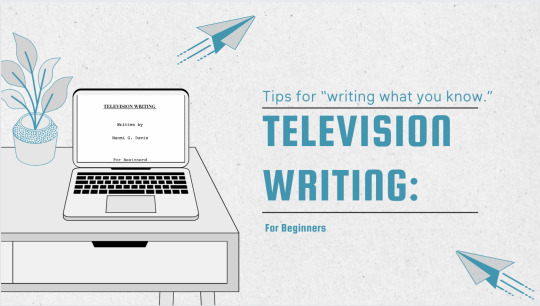
Over the years, due to the six shows I've been in the room for and my 19 years of entertainment industry experience, I have been a guest lecturer at NFMLA, Girls Write Now, NY Times Film School, and NYU - Tisch School of the Arts.
I'm in this group because I was a writer's PA and Writer's Assistant, but I was not promoted on the shows I was an assistant on. I optioned a pilot as an assistant and became a staff writer on a show I was completely unconnected to with the power of just my writing sample.
Over the years, many have pushed me to teach a course in order to share my unique take on "writing what you know" and writing a successful pilot script that will get you repped and staffed.
Here's the link: https://learntowritetv.teachable.com
I hope you'll check out my teachable course and I hope it will be helpful.
-N
In the course, "TV Writing For Beginners", experienced television writer Naomi G. Davis will introduce students to the fundamental principles and techniques of writing for television.
Whether you aspire to become a TV writer or simply want to explore the art of storytelling through this medium, this course will provide you with the tools and knowledge you need to get started.
From understanding the structure of a TV script to developing compelling characters and storylines, you will learn the essential skills required to craft engaging and entertaining television content from understanding story structure to crafting compelling dialogue and character arcs to elevate your TV writing skills.
#writing#writing tips#writerscommunity#TV#tv writing#Writing advice#writing resources#TV Writing tips#TV Show#The Marvelous Mrs. Maisel#The Get Down#Dash & Lily#Endgame#Splinter Cell#Endgame NBC#Writer#female writers#ao3 writer#on writing#writers#emerging writers#emerging writer#TV Writer's Room#Writer's Room
16 notes
·
View notes
Note
Dal, I want to start writing fanfic but I’m afraid that I won’t be able to write characters accurately. How do you get characterization of the characters you write so on point?
hello love! what a compliment! thank you so much!
for me, it’s a process of learning their mannerisms. i have an ungodly amount of time in bg3 (i’ve 100%-ed the game) and every single time i’ve tried to map out certain intonation patterns and gestures in comparison to people i’ve known in real life, things i’ve seen, media i’ve consumed.
here are some tips!
- consider the character before you. really get into their head. before they do anything, your first question should be ‘why are they doing this, and how does it benefit the plot?’ - and if you can’t think of three reasons as to why they are, then it needs more work.
- mannerisms are learned mainly through exposure. liken the character you’re trying to write about to others in media, to people you know, to things you’ve seen. take those and work with them until they feel malleable within the context of your character. a big one of these for me is astarion and little head tilts, expressive hands; and how that resembles both comfort and bravado. performance yet still deeply personal.
- sometimes ideas are great until you can’t explain them. it’s ok to scrap them or save them for later. if something doesn’t feel a hundred percent true to character while you’re still learning them, then don’t include it.
- you’re allowed to view a character differently to the way others do, so long as you can justify it. characterisation isn’t necessarily one size fits all. there is zero canonical explanation as to why astarion would have a raging breeding kink yet here i am.
if i think of anything else i’ll add it here!
go forth and create, my sweet dhampling!
15 notes
·
View notes
Text
A general cane guide for writers and artists (from a cane user, writer, and artist!)
Disclaimer: Though I have been using a cane for 6 years, I am not a doctor, nor am I by any means an expert. This guide is true to my experience, but there are as many ways to use a cane as there are cane users!
This guide will not include: White canes for blindness, crutches, walkers, or wheelchairs as I have no personal experience with these.
This is meant to be a general guide to get you started and avoid some common mishaps/misconceptions in your writing, but you absolutely should continue to do your own research outside of this guide!
This is NOT a medical resource!!! And never tell a real person you think they're using a cane wrong!

The biggest recurring problem I've seen is using the cane on the wrong side. The cane goes on the opposite side of the pain! If your character has even-sided pain or needs it for balance/weakness, then use the cane in the non-dominant hand to keep the dominant hand free. Some cane users also switch sides to give their arm a rest!
A cane takes about 20% of your weight off the opposite leg. It should fit within your natural gait and become something of an extension of your body. If you need more weight off than 20%, then crutches, a walker, or a wheelchair is needed.
Putting more pressure on the cane, using it on the wrong side, or having it at the wrong height can make it less effective, and can cause long term damage to your body from improper pressure and posture. (Hugh Laurie genuinely hurt his body from years of using a cane wrong on House!)
(some people elect to use a cane wrong for their personal situation despite this, everyone is different!)
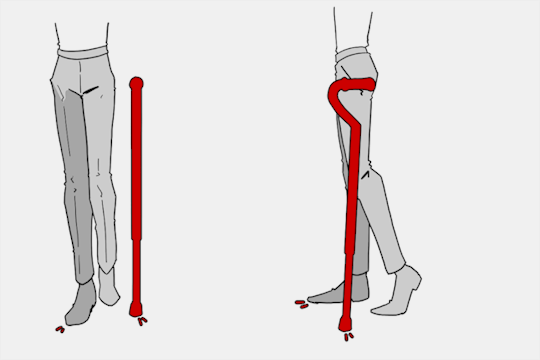
(an animated GIF of a cane matching the natural walking gait. It turns red when pressure is placed on it.)
When going up and down stairs, there is an ideal standard: You want to use the handrail and the cane at the same time, or prioritize the handrail if it's only on one side. When going up stairs you lead with your good leg and follow with the cane and hurt leg together. When going down stairs you lead with the cane and the bad leg and follow with the good leg!
Realistically though, many people don't move out of the way for cane users to access the railing, many stairs don't have railings, and many are wet, rusty, or generally not ideal to grip.
In these cases, if you have a friend nearby, holding on to them is a good idea. Or, take it one step at a time carefully if you're alone.
Now we come to a very common mistake I see... Using fashion canes for medical use!
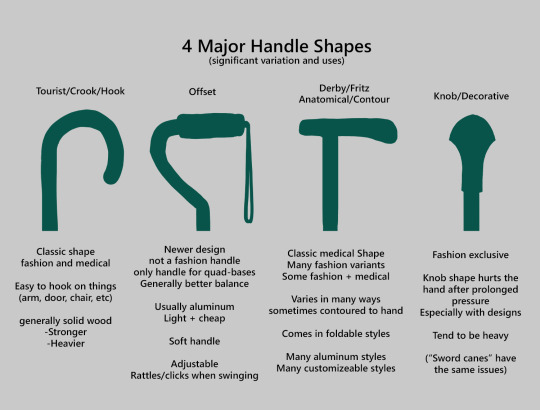
(These are 4 broad shapes, but there is INCREDIBLE variation in cane handles. Research heavily what will be best for your character's specific needs!)
The handle is the contact point for all the weight you're putting on your cane, and that pressure is being put onto your hand, wrist, and shoulder. So the shape is very important for long term use!
Knob handles (and very decorative handles) are not used for medical use for this reason. It adds extra stress to the body and can damage your hand to put constant pressure onto these painful shapes.
The weight of a cane is also incredibly important, as a heavier cane will cause wear on your body much faster. When you're using it all day, it gets heavy fast! If your character struggles with weakness, then they won't want a heavy cane if they can help it!
This is also part of why sword canes aren't usually very viable for medical use (along with them usually being knob handles) is that swords are extra weight!
However, a small knife or perhaps a retractable blade hidden within the base might be viable even for weak characters.
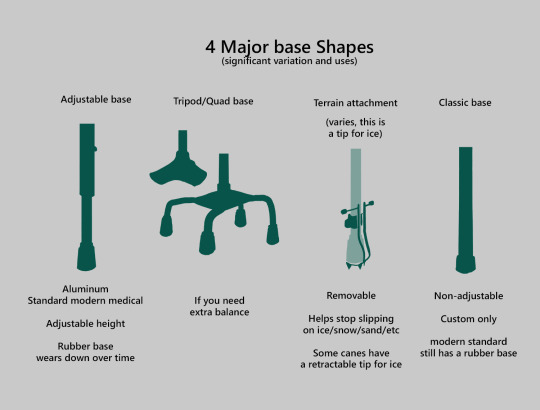
Bases have a lot of variability as well, and the modern standard is generally adjustable bases. Adjustable canes are very handy if your character regularly changes shoe height, for instance (gotta keep the height at your hip!)
Canes help on most terrain with their standard base and structure. But for some terrain, you might want a different base, or to forego the cane entirely! This article covers it pretty well.
Many cane users decorate their canes! Stickers are incredibly common, and painting canes is relatively common as well! You'll also see people replacing the standard wrist strap with a personalized one, or even adding a small charm to the ring the strap connects to. (nothing too large, or it gets annoying as the cane is swinging around everywhere)
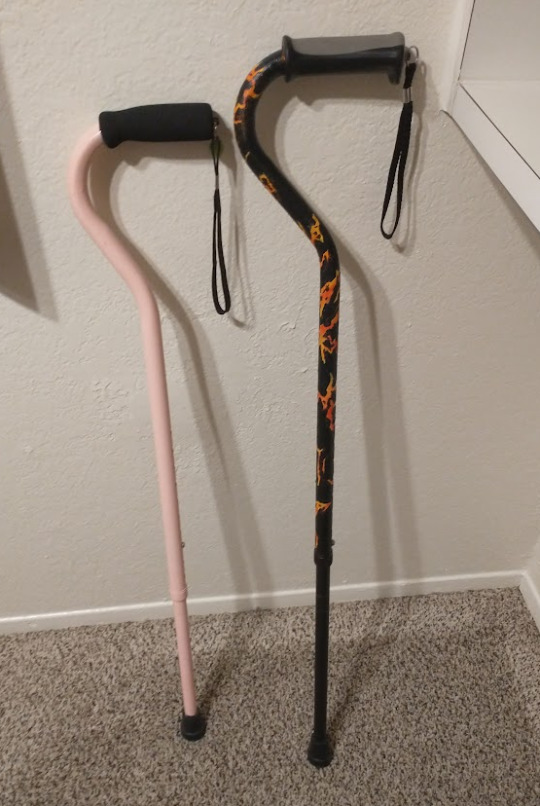
(my canes, for reference)
If your character uses a cane full time, then they might also have multiple canes that look different aesthetically to match their outfits!
When it comes to practical things outside of the cane, you reasonably only have one hand available while it's being used. Many people will hook their cane onto their arm or let it dangle on the strap (if they have one) while using their cane arm, but it's often significantly less convenient than 2 hands. But, if you need 2 hands, then it's either setting the cane down or letting it hang!
For this reason, optimizing one handed use is ideal! Keeping bags/items on the side of your free hand helps keep your items accessible.

When sitting, the cane either leans against a wall or table, goes under the chair, or hooks onto the back of the chair. (It often falls when hanging off of a chair, in my experience)
When getting up, the user will either use their cane to help them balance/support as they stand, or get up and then grab their cane. This depends on what it's being used for (balance vs pain when walking, for instance!)
That's everything I can think of for now. Thank you for reading my long-but-absolutely-not-comprehensive list of things to keep in mind when writing or drawing a cane user!
Happy disability pride month! Go forth and make more characters use canes!!!
#mobility aid#cane user#writing tips#writing advice#drawing tips#art tutorial#art tips#art reference#art resources#art help#my art#long post
73K notes
·
View notes
Text
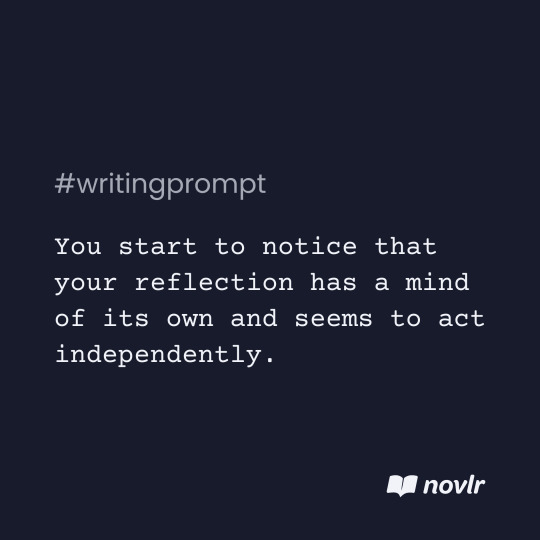
#writing prompt#writing prompts#idea#story ideas#ins#writing inspiration#writers#creative writing#writing#writing community#writers of tumblr#creative writers#writeblr#writerblr#writing tips#prom#story prompts#fic prompt#prompt#story prompt#writing ideas#story idea#writing idea#creative writing prompt#let's write#insp#story inspiration#creative inspiration#wri#writers block
23 notes
·
View notes
Text
Before you kill a character...
Consider the following.
Does it advance the plot?
Killing off a character should serve a purpose in propelling the story forward. It could introduce a new conflict, escalate existing tensions, or trigger a series of events that drive the plot in a new direction. If the character's death doesn't contribute to the overall narrative arc, it might feel gratuitous or unnecessary.
Does it fulfil their personal goal?
Each character has their own arcs and objectives within the story. If the character's death aligns with or resolves their personal journey or goal, it can add depth and closure to their character arc. Conversely, if their death feels disconnected from their goals or character development, it may come across as arbitrary or unsatisfying.
Does it emphasise the theme?
The death of a character can highlight or support key themes by demonstrating their consequences or illustrating the moral dilemmas faced by the remaining characters. A well-executed death can deepen the audience's understanding of the story's themes and add layers of complexity to the narrative.
Does it motivate other characters?
Character deaths can serve as catalysts for growth or change in other characters. The loss of a loved one or ally can drive characters to reevaluate their beliefs, make difficult decisions, or embark on new paths. The impact of the death on other characters can reveal their strengths, weaknesses, and relationships, adding depth to the story's interpersonal dynamics.
Does it create realism?
The inclusion of death can lend authenticity to the story world. If the character's death feels earned and plausible within the context of the narrative, it can enhance the story's credibility and emotional resonance. However, if the death feels contrived or forced, it may strain the reader's suspension of disbelief.
Is it a fitting recompense?
In some cases, characters may meet their demise as a consequence of their actions or decisions. If the character's death serves as a form of justice or retribution for their deeds, it can feel narratively satisfying and thematically resonant. However, if the death feels arbitrary or disconnected from the character's arc or the story's events, it may feel unsatisfying or even unjustified.
Don't kill off a character for the sake of shocking the reader or invoking sadness; when considering whether to kill off a character in your story, it's crucial to ensure their demise serves a purpose beyond mere shock value or convenience. Ensure each character serves a purpose that enriches and enhances the story to avoid having to eliminate them solely for convenience. Don't use death as a means to remove an extra or irrelevant character—you shouldn't have them in the first place, if they're disposable. Doing so will undermine the depth and integrity of the narrative.
Hope this was helpful! Happy writing ❤
#writeblr#writing#writing tips#writing advice#writing help#writing resources#creative writing#character writing#plot development#deception-united
41 notes
·
View notes
Text
If you want to write a dumb little story with a dumb little plot and ridiculously silly characters. No one's stopping you. Genuinely, no one should be allowed to stop you. Write that dumb story with your whole heart and don't hold back.
#look I've deleted fics that made me feel awful#There's a time and a place#A good idea will come back to you again#But some things should be given time to settle#writeblr#writing tips#writing#writer advice#writers on tumblr
71K notes
·
View notes
Text
things people do after having a nightmare that isn’t crying
struggle to catch their breath
grab onto whatever’s close enough to ground themselves in reality
become nauseous / vomit
shake uncontrollably
sweat buckets
get a headache
things people do to combat having nightmares if they occur commonly
sleep near other people so they can hear the idle sounds of them completing tasks
move to a different sleeping spot than where they had the nightmare
leave tvs / radios / phones on with noise
just not sleep (if you want to go the insomnia route)
sleep during the day in bright rooms
things people with insomnia do
first, obviously, their ability to remember things and their coordination will go out the window
its likely they’ll become irritable or overly emotional
their body will start to ache, shake, and weaken
hallucinate if it’s been long enough
it becomes incredibly easy for them to get sick (and they probably will)
add your own in reblogs/comments!
33K notes
·
View notes